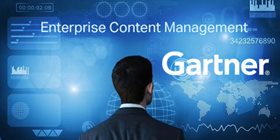CMS Features, mCommerce, MCM, Gartner and More
The first week of 2017 has come to a close and the buzz around CMS-Connected was geared toward ECM, automation, CMS, and mobile, both in mCommerce and the discussion of the mobile content management market with Aragon Research analyst Jim Lundy. Read on for a brief overview and commentary on each.
5 Features Your Content Management System Must Have
So you’re doing research on content management systems, you’re hearing what other people have said but can’t quite get a handle on what you as an individual within an organization need. There are so many features out there, and beyond that, so many ways the same features are described from different vendors. How do you know what is important?
get a handle on what you as an individual within an organization need. There are so many features out there, and beyond that, so many ways the same features are described from different vendors. How do you know what is important?
Mark Grannan of Forrester Research said it best when he said to look at the specific goals your business has, and never lose sight of those goals through the choice and integration of a CMS, but, there are some features we here at CMS-Connected think every organization should look for when they make the decision on which CMS will be theirs. Venus chose a handful (quite literally five), and went into very understandable detail, even relating those features directly to business outcomes, to highlight the inherent value of each.
To boil it down even more simply, your content should be personalized and where it lives, should be structured and accessible. The interactivity of your system with others matters, and the sharing of data shouldn’t be a headache. Permissions are of the utmost importance to understand however, and controls should be there to allocate access to differing job roles. Restrictions aren’t always the most fun task to think about or decide on, but the management of information is easier than damage control when something goes awry. Finally, support for multiple languages is key, especially if your organization is eyeing a position in the global market. However, you may say you’re not at that stage of the game but that could change, and you’ll want those capabilities there as opposed to having to acquire them after. Your business could strike a chord with a market you haven’t yet thought of, so why not welcome them with open arms by supporting a conversation in their mother tongue?
Read the full article here.
5 Emerging mCommerce Technology Innovations
 It’s no wonder mCommerce sales are expected to grow nearly 260% by 2020, with all of the new technological innovations that have come out to contribute to that rise. Mobile conversion rates are still lower than desktop, which could be for any number of reasons, one of which might be retailers, some national, (I won’t name names) who still don’t have sites as responsive as they should be but, I digress.
It’s no wonder mCommerce sales are expected to grow nearly 260% by 2020, with all of the new technological innovations that have come out to contribute to that rise. Mobile conversion rates are still lower than desktop, which could be for any number of reasons, one of which might be retailers, some national, (I won’t name names) who still don’t have sites as responsive as they should be but, I digress.
MIR technology would have to be one of the easiest ways to bring up an online retailers mCommerce conversion rate, it’s like Shazam for products! The biggest reason this works? Aside from being easy, it intervenes at the visual stage, perhaps when a customer initially sees an item when the ‘need’ feelings are at their peak. And to showcase not just one piece of an outfit, but the whole thing? Far more likely for the consumer to purchase all of the items impulsively, than taking the time to mull it over and only buy one, later on when they’re at their desktop.
Aside from ease of purchase, mCommerce holds the greatest level of access to customers, and that level of access should be the linchpin for every technology that exists and is in the works. Once retailers truly understand how to leverage that in a non-obtrusive way, they can start to take their share of the mCommerce pie.
Read the full article here.
Why Enterprises Struggle with IT Automation & Where to Begin
The percentage of enterprises with more than four diverse automation technologies within their IT  management profiles has jumped from less than 20% in 2014 to 75% in 2017, yet, it’s understood that many still struggle with the efficiency of automation. In our midweek article, we look at why this may be, and the ways in which the situation can be improved so enterprise organizations can begin to truly benefit from the value proposition of automation.
management profiles has jumped from less than 20% in 2014 to 75% in 2017, yet, it’s understood that many still struggle with the efficiency of automation. In our midweek article, we look at why this may be, and the ways in which the situation can be improved so enterprise organizations can begin to truly benefit from the value proposition of automation.
One of the stand-out thoughts, is for enterprises to not automate for the sake of automation, but to develop a strategy before implementation that takes into account the cost and efficiency of automating the task, or keeping it manual. Approach it pragmatically, by looking at the cost manually vs automating the effort, then determine how much will be saved in time and resources, keeping in mind the necessity (and extent) of human intervention, should something go awry.
As Venus points out, the necessity of an automation evangelist so to speak can be crucial, as a cheerleader for the benefits of automation. The largest benefit being the amount of human effort that can be put to use in more high-skilled areas by removing repetitive work and automating traditional tasks, as this could bring about worry from employees about being replaced or taking on new challenges.
Read the full article here.
Jim Lundy of Aragon Research on Mobile Content Management
 Cloud seemed to dominate the conversation in 2016, which inevitably, brought about the discussion of mobile, and with that, Mobile Content Management (MCM). In early December, Aragon Research released their Globe for Mobile Content Management 2016, discussing 17 providers in the MCM market and what will shape that market in 2017. Towards the end of the week, I interviewed Jim Lundy, the author of the report and CEO and Lead Analyst at Aragon Research, to hear his first-hand thoughts on the MCM Market.
Cloud seemed to dominate the conversation in 2016, which inevitably, brought about the discussion of mobile, and with that, Mobile Content Management (MCM). In early December, Aragon Research released their Globe for Mobile Content Management 2016, discussing 17 providers in the MCM market and what will shape that market in 2017. Towards the end of the week, I interviewed Jim Lundy, the author of the report and CEO and Lead Analyst at Aragon Research, to hear his first-hand thoughts on the MCM Market.
If you would like read a more in-depth analysis of the MCM market, how vendors can improve their market share and advice to buyers who are looking for their own MCM system, read the full article here.
Gartner Reveals Critical Capabilities for ECM
As a follow-up to their annual report, The Magic Quadrant for Enterprise Content Management, Gartner  released a companion report: Gartner’s Critical Capabilities for Enterprise Content Management. The difference is best said by authors of the report, Karen M. Shegda and Gavin Tay: “The Magic Quadrant assesses the ECM vendors with respect to their ability to execute in the market and their vision. This Critical Capabilities document assesses the 15 vendors in terms of their ECM suites’ functional capabilities to support the following five use cases: personal and team productivity, records management and compliance, process applications, content ecosystem and finally, digital transformation/modernization”
released a companion report: Gartner’s Critical Capabilities for Enterprise Content Management. The difference is best said by authors of the report, Karen M. Shegda and Gavin Tay: “The Magic Quadrant assesses the ECM vendors with respect to their ability to execute in the market and their vision. This Critical Capabilities document assesses the 15 vendors in terms of their ECM suites’ functional capabilities to support the following five use cases: personal and team productivity, records management and compliance, process applications, content ecosystem and finally, digital transformation/modernization”
Venus unpacked each use case, highlighting a few of the vendors’ strengths and weaknesses in each. Interestingly, when discussing Dell EMC’s Documentum family, she pointed out they have been thought to lag behind other competitors in their ability to support personal and team productivity as the capabilities were limited by a reliance on integrations with Microsoft SharePoint and Syncplicity. However, their new Leap Platform can change this for Dell EMC as it supports content sharing and external document exchange. This brought to mind an interview I had with Christopher McLaughlin, Chief Marketing Officer, Enterprise Content Division at EMC, where he goes a bit more in-depth on their new Leap platform:
Read the full article on Gartner’s Critical Capabilities for Enterprise Content Management report.

Laura Myers
A digital business, marketing and social media enthusiast, Laura thrives on asking unique, insightful questions to ignite conversation. At an event or remotely, she enjoys any opportunity to connect with like-minded people in the industry.